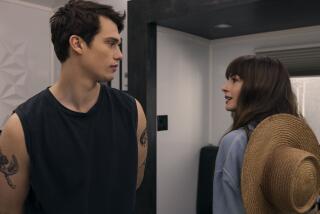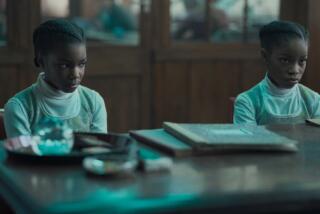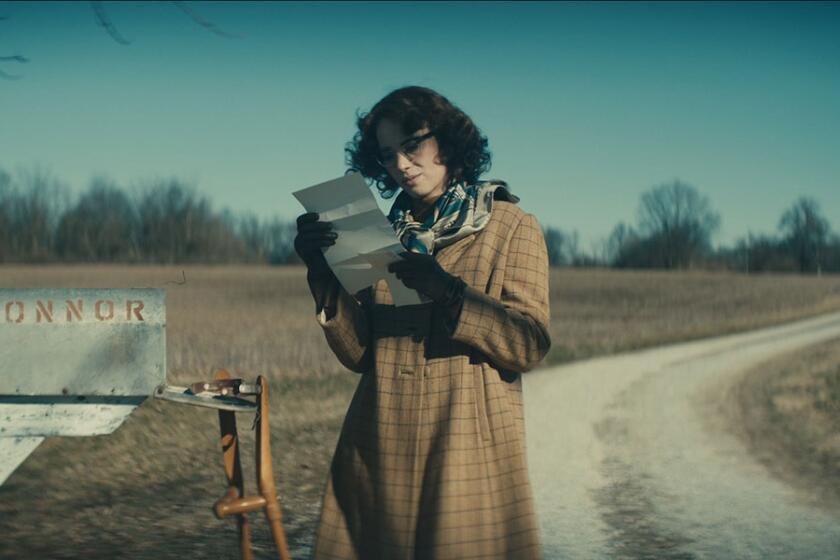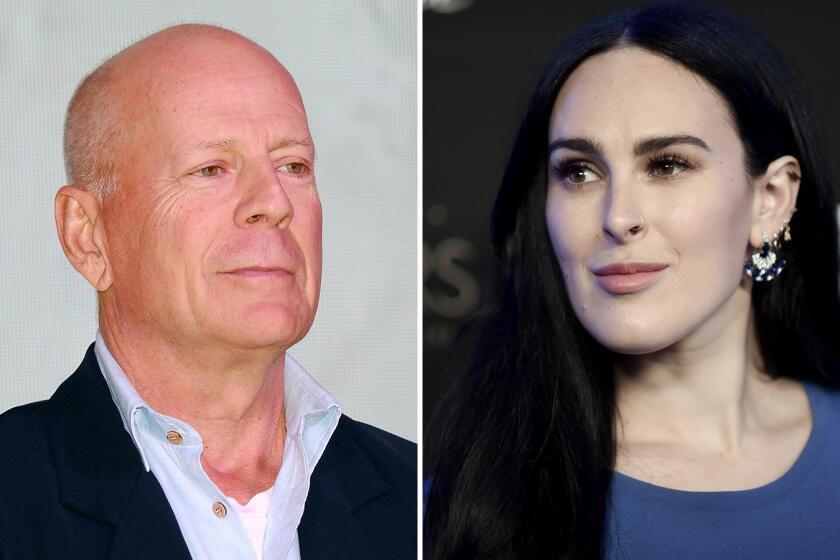They hold the purse
When Disney’s “Calendar Girls” was released in England four months ago, it was No. 1 at the box office for four weeks running. But that wasn’t the statistic that had industry analysts buzzing. UCI, the largest chain of movie theaters in the United Kingdom, reported a potent 500% increase in tea sales at concession stands, indicating that “Calendar Girls” was drawing an older crowd. “I just envisage middle-aged women with their husbands having a cup before the movie,” says “Calendar Girls” director Nigel Cole.
It was just one not-so-small reminder to the youth-obsessed movie marketing culture that women born before 1964 not only like to go to the multiplex but can be a force to be reckoned with.
“Calendar Girls,” opening here on Friday, tells the story, based on true events, of 11 women, ages 45 to 66, who raised money for leukemia research by posing nude for a calendar, becoming media stars in the process. The film has some of England’s most beloved 50- and 60-something actresses -- including Julie Walters and Helen Mirren -- baring skin, and though we see little of them (they’re positioned behind Belgian buns or a watering can) none appears to have seen the inside of a Pilates studio recently.
They look proud nonetheless. “It wasn’t about, ‘Oh, you can look gorgeous at 58 without Botox!’ ” says Helen Mirren. “It’s about playing characters who are interesting to watch. The problem in general with women in movies is that their characters are usually dumb, with no identity, and are made to do really stupid things. They have no role in the story except as a cipher to feed the plot. That’s what concerns me.”
“Calendar Girls” isn’t the only film this season that features actresses of Mirren’s quality and age as central protagonists. Writer-director Nancy Meyers’ new comedy, “Something’s Gotta Give,” which opened Friday, is a star vehicle for Diane Keaton, 57.
Not that the universe has completely turned on its head. When two-time Oscar winner Jessica Lange takes the screen as Albert Finney’s staunchly loyal wife in Tim Burton’s “Big Fish,” her on-screen time is so minimal -- save for a key scene in which she sinks fully clothed into a bathtub to administer a heartbreakingly tender hug to her ailing husband -- it makes one wonder, “Is this the meatiest mainstream role she’s been offered lately?”
Nevertheless, a case could be made that it’s a great time to be Lange, age 54, Susan Sarandon (57), Sissy Spacek (53), Sigourney Weaver (54), Geena Davis (47) or Meryl Streep (54). After all, there are 76 million baby boomers -- people ages 39 to 57 -- in the U.S., according to the Census Bureau, with women outnumbering men 51% to 49%.
It’s a group that, as an audience, might take offense at watching the same leading ladies they grew up with being shuttled off to the edges of the screen. And those in this category who make movies -- executives, screenwriters, directors -- should know better than to ignore their peers’ purchasing worth. “Our checkbooks are the biggest, and everything we do is so magnified because there’s so many of us,” reasons Jan Reisen, co-founder of a Web site called Baby Boomer Generation (www.aginghipsters.com). “I don’t see this generation standing for portrayals of women as Granny.” (Or “the wife.” More than one critic noted the oddity of seeing Debra Winger -- one of the ‘80s’ iconic actresses -- emerge from semiretirement to play the trifling role of a coach’s smilingly supportive spouse in the fall release “Radio.”) Showcasing actresses of a certain age, it seems, could make luring boomer gals into movie theaters as easy as pulling in the under-25 gang during the teen flick explosion. But Adam Dawtrey, European editor of Variety, says that’s easier said than done.
“Teens are so easy to market to -- you can tell them anything and they’ll believe it,” Dawtrey says. “This is a very demanding audience; they won’t just go and see anything. They’re wealthy, with lots of leisure money to spend. They’re kind of the Holy Grail for producers, worldwide. But they’re not an easy demographic to reach. They’re not suckers.”
Refreshing plot
It’s hard not to be intrigued by the two-minute trailer for “Something’s Gotta Give.” In a quick mix of film clips and voice-over, it’s established that Jack Nicholson is a grinning bachelor playboy with a preference for dating much, much younger women. In the East Hamptons after suffering a minor heart attack, he finds himself competing with his cardiologist (Keanu Reeves) for the attentions of Diane Keaton, the divorced playwright mother of this aging lothario’s latest girlfriend (Amanda Peet).
The falling-for-the-mom plot twist was so irresistible that when Meyers pitched it over lunch to Sony chief Amy Pascal, the studio head said yes immediately. “It was understood that this was a movie about two people who fall in love late in life,” Meyers says. “No one wanted to make it with younger people. There was no ‘Couldn’t they be in their 40s?’ I definitely wanted to always keep their ages relevant.” “Something’s Gotta Give” is filled with stage-of-life humor about things like reading glasses and blood pressure. “This isn’t a movie that Drew Barrymore could slip into.”
“Something’s Gotta Give” is being released at a time when great on-screen couples -- modern equivalents to Powell and Loy, Tracy and Hepburn -- have gone missing. Though romantic comedies featuring younger stars abound, watching them come together is like opening beautifully wrapped gifts that turn out to be empty. None of the pairings manages to send off sparks. Is there anyone out there dying to see, say, Kate Hudson team again with Matthew McConaughey? In fact, the closest the movies have come recently to a love affair that resonated with the public was the nonsexual relationship between old souls Bill Murray, 53, and Scarlett Johansson, 19, in “Lost in Translation.”
Is a new cycle of romantic comedies -- ones with more at stake -- upon us? If Keaton and Nicholson’s best moments together in “Something’s Gotta Give” feel complicated, it’s because their every vocal tic and familiar mannerism triggers thoughts of their film and personal histories. Watching these two all-American movie stars as they trade looks, quips and experience-drenched bits makes it seem as if they have a mile-long list of shared credits even though they’ve worked together only once before.
“Something’s Gotta Give” certainly has an air of wish-fulfillment fantasy to it, as did Meyers’ last table-turning adult comedy about male-female relations, “What Women Want,” which starred Mel Gibson as a swaggering ad exec flummoxed by the ability to hear women’s thoughts -- and which grossed $182 million domestically.
Early on in “Something’s Gotta Give,” Frances McDormand, who plays Zoe, Keaton’s college-professor sister, delivers an elaborate dinner-table rant about the plight of the single middle-aged woman. Unattached older women are branded as spinsters, she reasons, while men of the same generation are envied by all as freewheeling and mysterious. Yet when older women -- through sheer necessity -- become more productive and therefore more interesting, it backfires, because guys, especially older ones, are intimidated by them. “Thank God men die younger than us,” Zoe concludes, only half-jokingly. “It’s the only break we get.”
Now 53, Meyers is forging her own way in the filmmaking world after the breakup of a long marriage and movie partnership with writer-director Charles Shyer. But when asked about the origins of Zoe’s speech, she turned coy.
“I have no idea -- I just sort of thought I wanted to lay it all out there,” she said, then mentioned that she’d just shown the scene to McDormand. Did it go over well? “She was very happy with it. She said, ‘How about if we run it in Times Square?’ ”
Eureka moments
What would the creators of “Love Actually” make of Zoe’s screed? Directed by Richard Curtis and billing itself as the “ultimate” romantic comedy, “Love Actually” contains all manner of airy falling-in-love couples in its eight story lines, but none of them involves middle-aged women. The one representative of this group -- played by 44-year-old Emma Thompson -- bemoans her dumpy body and wardrobe while watching her husband (Alan Rickman) consider an affair with his sexy young secretary (Heike Makatsch).
“Love Actually” is nonetheless proving to be a feel-good year-end hit. But if “Calendar Girls” and “Something’s Gotta Give” are huge hits as well, will it mean anything? “When ‘First Wives Club’ came out it was, like, ‘Oh! There are women who want to see it! We should be making movies for these women, not just for young girls!’ ” says Entertainment Weekly film critic Lisa Schwartzbaum. “And the answer is, of course you should. These are women who can buy their own movie tickets. I have no deep insight into this. It feels like every single time a movie is made about a woman who is over 35 and an audience responds, the people who read the box office numbers are surprised. They say, ‘Wow! Yes, there are women who want to go to the movies!’ And, yet, they’re always there.”
More to Read
Only good movies
Get the Indie Focus newsletter, Mark Olsen's weekly guide to the world of cinema.
You may occasionally receive promotional content from the Los Angeles Times.






